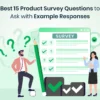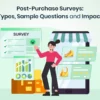Companies have been losing almost $1.6 trillion per annum because of customer churn. Also, the study from Forrester states, it costs 5 times as much to acquire new customers than it is to retain one. To make it worse, it will cost your business 16 times more to acquire a new customer up to your existing customer level of customer. Every business realizes the fact that the more customers a business is able to retain, the more revenue it would earn.
For instance, according to the Harvard Business School study, 5% average increase in retaining customers would result in a net 25% to 95% appending in profits. One must remember that 65% of any company’s total share comes from its existing customers.
📈 Close the loop, boost satisfaction! 🛠️
Enhance your customer experience with piHappiness❤ today!If we look at the table below, we can understand the most significant revenue drivers for any business:
- Customer retention – 52%
- Customer acquisition – 45%
- Product innovations – 30%
- Strategies for new merchandize – 25%
- Newer sales channels – 19 %
- Technological advancements – 16%
- Acquiring new markets or business – 11%
Further, Gartner suggests, a staggering figure of 80% of any company’s future earning comes from a mere 20% of the business’s existing customers. Also, according to Marketing Metrics, there is 60% to 70% greater probability of selling to the existing customers and a mere 5% to 20% would be to new prospects.
Indeed, the stakes are really high for customer retention and any deviation from it brings customer churn. Yes, at least a great amount of attention has been drawn on churn, yet nothing has been told about what churn actually is.
Customer churn – what is it?
When your customers are not satisfied with your business, what services or products you sell – they stop their interaction with you and look elsewhere. This entire process where the customers leave a brand because of being dissatisfied is termed as customer churn.
Studies reveal that after just one negative instance of dissatisfaction, 51% of your customers will never do business with you ever again. Hence, for companies to retain their customers and avoid churn, customer feedback is taken at regular intervals. Today, the process has been made smooth and effortless with the help of customer feedback apps. These apps provide customized questions that help the customers answer what they have liked in a brand, what was lacking, and what left a bad taste with them. Customer feedback software have already become an essential part of businesses as they keep the business aware of the likes and dislikes of customers.
While customer feedback is vital for any business to grow, the question worth asking is – is it worthwhile to invest the time and your resources in the collection of customer feedback if you haven’t closed the loop? There is a huge misconception that closing the feedback loop is associated with the closing customer feedback. One must understand that how when the feedback loop is open, it results in churn or customer attrition.
Not closing the customer feedback loop can end up in customer churn
In case of an agitated customer, if you are just sending a note acknowledging the customer’s concern, you haven’t closed the loop. Certain measures have to be taken to create a happy customer out of your agitated customer to retain him/her. Some of these are:
- Customers regularly receive automated messages and are able to easily differentiate personalized and automated messages. Sending automated messages does not add any value to the communication. To close the loop you need to take concrete action.
- Sending product updates or newsletters can be a good idea. However, to add value to your customer interaction, you need to address individual issues to be able to close the loop.
- Just by answering customer queries or fixing major bugs, you are not closing the loop. You need to find out how better you could serve your customers to appease them.
Apart from doing the things mentioned above, there are other things that the customer has to do to close the customer feedback loop. Customer feedback loop closure goes beyond mere acknowledgment of customer concerns. It has to do with understanding deep of the customer pain points and resolving them. Only when your customers are happy and satisfied again, you can be assured that the loop is closed. A really good method of gathering customer concerns and closing them is by using customer feedback software. These apps come with tailor-made questions that can easily identify the customer concerns and provide you deeper insights into customer needs.
Check these sure-shot ways that can help you close the loop of customer feedback and prevent customer churn:
- Always acknowledge customer feedback
- Along with customized responses, send an action plan
- Set clear expectations with your customers and meet them
- Extricate internal bottlenecks
- Take instant action and inform your customer
- Always acknowledge positive feedback
- Keep your conversation active
To Conclude:
The first thing the brand should do while closing the feedback loop is to acknowledge and address it. This gives your customer the assurance that you take their feedback seriously. 50% of the customers give every brand a week time before moving to the next brand. So, your acknowledgment and addressing should not only be timely but proactive. To make your customer retention procedure better, you need to send a personalized response and action plan. 88% of the US businesses have reported finding measurable improvements owing to personalization. This provides a lift higher than 10%. Along with setting timelines with your customers and adhering to them diligently, you need to need to maintain the turn-around-time (TAT). Research finds 67% of the customers can be retained if brands resolving customer issues succeed in the first engagement.
Finally, along with all the external issues that help in removing the customer feedback loop and enable customer retention, one internal factor is a great way to close loops. If you create a strong internal team, where the entire team is empowered and also encouraged to communicate with the customers. If the team works in tandem, every member of the team would be in a position to answer customer queries and help in resolving the issue quickly. Moreover, leverage the customer feedback management software to address the pain points faster and with a more professional approach.
Be the delight your customer wants your brand to bring!








